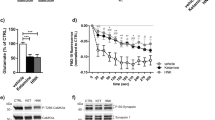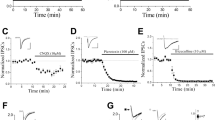Abstract
Excitatory brain synapses are strengthened or weakened in response to specific patterns of synaptic activation, and these changes in synaptic strength are thought to underlie persistent pathologies such as drug addiction, as well as learning1. In contrast, there are few examples of synaptic plasticity of inhibitory GABA (γ-aminobutyric acid)-releasing synapses. Here we report long-term potentiation of GABAA-mediated synaptic transmission (LTPGABA) onto dopamine neurons of the rat brain ventral tegmental area, a region required for the development of drug addiction. This novel form of LTP is heterosynaptic, requiring postsynaptic NMDA (N-methyl-d-aspartate) receptor activation at glutamate synapses, but resulting from increased GABA release at neighbouring inhibitory nerve terminals. NMDA receptor activation produces nitric oxide, a retrograde signal released from the postsynaptic dopamine neuron. Nitric oxide initiates LTPGABA by activating guanylate cyclase in GABA-releasing nerve terminals. Exposure to morphine both in vitro and in vivo prevents LTPGABA. Whereas brief treatment with morphine in vitro blocks LTPGABA by inhibiting presynaptic glutamate release, in vivo exposure to morphine persistently interrupts signalling from nitric oxide to guanylate cyclase. These neuroadaptations to opioid drugs might contribute to early stages of addiction, and may potentially be exploited therapeutically using drugs targeting GABAA receptors.
This is a preview of subscription content, access via your institution
Access options
Subscribe to this journal
Receive 51 print issues and online access
$199.00 per year
only $3.90 per issue
Buy this article
- Purchase on Springer Link
- Instant access to full article PDF
Prices may be subject to local taxes which are calculated during checkout




Similar content being viewed by others
References
Malenka, R. C. & Bear, M. F. LTP and LTD: an embarrassment of riches. Neuron 44, 5–21 (2004)
Yim, C. Y. & Mogenson, G. Electrophysiological studies of neurons in the ventral tegmental area of Tsai. Brain Res. 181, 301–313 (1980)
Johnson, S. W. & North, R. A. Opioids excite dopamine neurons by hyperpolarization of local interneurons. J. Neurosci. 12, 483–488 (1992)
Zalutsky, R. A. & Nicoll, R. A. Comparison of two forms of long-term potentiation in single hippocampal neurons. Science 248, 1619–1624 (1990)
Stern, J. E. & Ludwig, M. NO inhibits supraoptic oxytocin and vasopressin neurons via activation of GABAergic synaptic inputs. Am. J. Physiol. 28, R1815–R1822 (2001)
Li, D. P., Chen, S. R. & Pan, H. L. Nitric oxide inhibits spinally projecting paraventricular neurons through potentiation of presynaptic GABA release. J. Neurophysiol. 88, 2664–2674 (2002)
Yu, D. & Eldred, W. D. Nitric oxide stimulates γ-aminobutyric acid release and inhibits glycine release in retina. J. Comp. Neurol. 483, 278–291 (2005)
Klejbor, I., Domaradzka-Pytel, B., Ludkiewicz, B., Wojcik, S. & Morys, J. The relationships between neurons containing dopamine and nitric oxide synthase in the ventral tegmental area. Folia Histochem. Cytobiol. 42, 83–87 (2004)
Brenman, J. E. & Bredt, D. S. Synaptic signaling by nitric oxide. Curr. Opin. Neurobiol. 7, 374–378 (1997)
Safo, P. K., Cravatt, B. F. & Regehr, W. G. Retrograde endocannabinoid signaling in the cerebellar cortex. Cerebellum 5, 134–145 (2006)
Aizenman, C. D., Manis, P. B. & Linden, D. J. Polarity of long-term synaptic gain change is related to postsynaptic spike firing at a cerebellar inhibitory synapse. Neuron 21, 827–835 (1998)
Shew, T., Yip, S. & Sastry, B. R. Mechanisms involved in tetanus-induced potentiation of fast IPSCs in rat hippocampal CA1 neurons. J. Neurophysiol. 83, 3388–3401 (2001)
Komatsu, Y. GABAB receptors, monoamine receptors, and postsynaptic inositol trisphosphate-induced Ca2+ release are involved in the induction of long-term potentiation at visual cortical inhibitory synapses. J. Neurosci. 16, 6342–6352 (1996)
Ouardouz, M. & Sastry, B. R. Mechanisms underlying LTP of inhibitory synaptic transmission in the deep cerebellar nuclei. J. Neurophysiol. 84, 1414–1421 (2000)
Mansvelder, H. D. & McGehee, D. S. Long-term potentiation of excitatory inputs to brain reward areas by nicotine. Neuron 27, 349–357 (2000)
Ungless, M. A., Whistler, J. L., Malenka, R. C. & Bonci, A. Single cocaine exposure in vivo induces long-term potentiation in dopamine neurons. Nature 411, 583–587 (2001)
Saal, D., Dong, Y., Bonci, A. & Malenka, R. C. Drugs of abuse and stress trigger a common synaptic adaptation in dopamine neurons. Neuron 37, 577–582 (2003)
Faleiro, L. J., Jones, S. & Kauer, J. A. Rapid synaptic plasticity of glutamatergic synapses on dopamine neurons in the ventral tegmental area in response to acute amphetamine injection. Neuropsychopharmacology 29, 2115–2125 (2004)
Liu, Q. S., Pu, L. & Poo, M. M. Repeated cocaine exposure in vivo facilitates LTP induction in midbrain dopamine neurons. Nature 437, 1027–1031 (2005)
Bonci, A. & Williams, J. T. A common mechanism mediates long-term changes in synaptic transmission after chronic cocaine and morphine. Neuron 16, 631–639 (1996)
Shoji, Y., Delfs, J. & Williams, J. T. Presynaptic inhibition of GABAB-mediated synaptic potentials in the ventral tegmental area during morphine withdrawal. J. Neurosci. 19, 2347–2355 (1999)
Melis, M., Camarini, R., Ungless, M. A. & Bonci, A. Long-lasting potentiation of GABAergic synapses in dopamine neurons after a single in vivo ethanol exposure. J. Neurosci. 22, 2074–2082 (2002)
Margolis, E. B. et al. κ opioids selectively control dopaminergic neurons projecting to the prefrontal cortex. Proc. Natl Acad. Sci. USA 103, 2938–2942 (2006)
Schulteis, G., Heyser, C. J. & Koob, G. F. Opiate withdrawal signs precipitated by naloxone following a single exposure to morphine: potentiation with a second morphine exposure. Psychopharmacology 129, 56–65 (1997)
Vanderschuren, L. J., De Vries, T. J., Wardeh, G., Hogemboom, F. A. & Schoffelmeer, A. N. A single exposure to morphine induces long-lasting behavioural and neurochemical sensitization in rats. Eur. J. Neurosci. 14, 1533–1538 (2001)
Carlezon, W. A. et al. Sensitization to morphine induced by viral-mediated gene transfer. Science 277, 812–814 (1997)
Williams, J. T., Christie, M. J. & Manzoni, O. Cellular and synaptic adaptations mediating opioid dependence. Physiol. Rev. 81, 299–343 (2001)
Stromberg, M. F., Mackler, S. A., Volpicelli, J. R., O’Brien, C. P. & Dewey, S. L. The effect of γ-vinyl-GABA on the consumption of concurrently available oral cocaine and ethanol in the rat. Pharmacol. Biochem. Behav. 68, 291–299 (2001)
Brodie, J. D., Figueroa, E. & Dewey, S. L. Treating cocaine addiction: from preclinical to clinical trial experience with γ-vinyl GABA. Synapse 50, 261–265 (2003)
Barrett, A. C., Negus, S. S., Mello, N. K. & Caine, S. B. Effect of GABA agonists and GABA-A receptor modulators on cocaine- and food-maintained responding and cocaine discrimination in rats. J. Pharmacol. Exp. Ther. 315, 858–871 (2005)
Acknowledgements
This work was supported by NIH grants to J.A.K. and E.C.P. We are grateful to B. Connors and C. Aizenman for discussions and to J. Downing-Park for technical assistance.
Author information
Authors and Affiliations
Corresponding author
Ethics declarations
Competing interests
Reprints and permissions information is available at www.nature.com/reprints. The authors declare no competing financial interests.
Supplementary information
Supplementary Information
This file contains Supplementary Figures 1-3 with Legends, Supplementary Methods and additional references. (PDF 1782 kb)
Rights and permissions
About this article
Cite this article
Nugent, F., Penick, E. & Kauer, J. Opioids block long-term potentiation of inhibitory synapses. Nature 446, 1086–1090 (2007). https://doi.org/10.1038/nature05726
Received:
Accepted:
Issue Date:
DOI: https://doi.org/10.1038/nature05726
This article is cited by
-
Heterosynaptic plasticity-induced modulation of synapses
The Journal of Physiological Sciences (2023)
-
Sex differences in VTA GABA transmission and plasticity during opioid withdrawal
Scientific Reports (2023)
-
Ethanol blocks a novel form of iLTD, but not iLTP of inhibitory inputs to VTA GABA neurons
Neuropsychopharmacology (2023)
-
Addiction-induced plasticity in underlying neural circuits
Neurological Sciences (2022)
-
Nitric Oxide Signaling Pathway in Ventral Tegmental Area is Involved in Regulation of 7,8-Dihydroxyflavone on Alcohol Consumption in Rats
Molecular Neurobiology (2022)
Comments
By submitting a comment you agree to abide by our Terms and Community Guidelines. If you find something abusive or that does not comply with our terms or guidelines please flag it as inappropriate.



